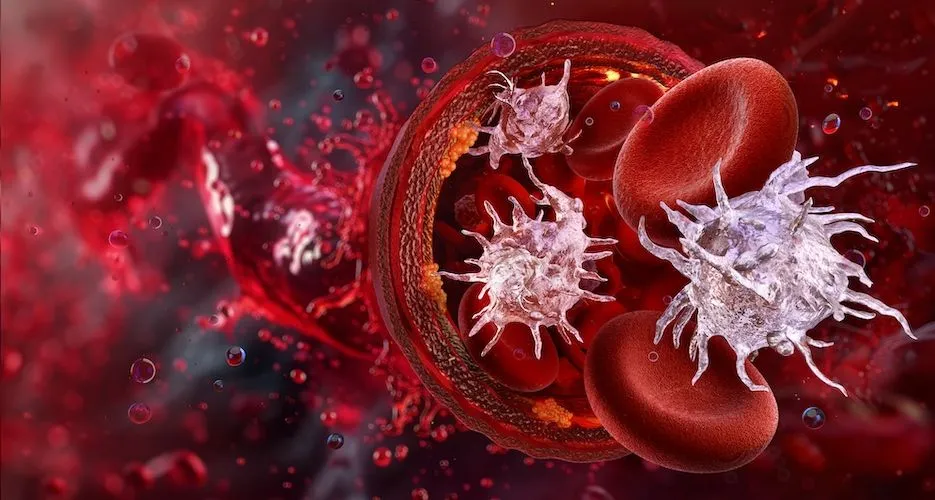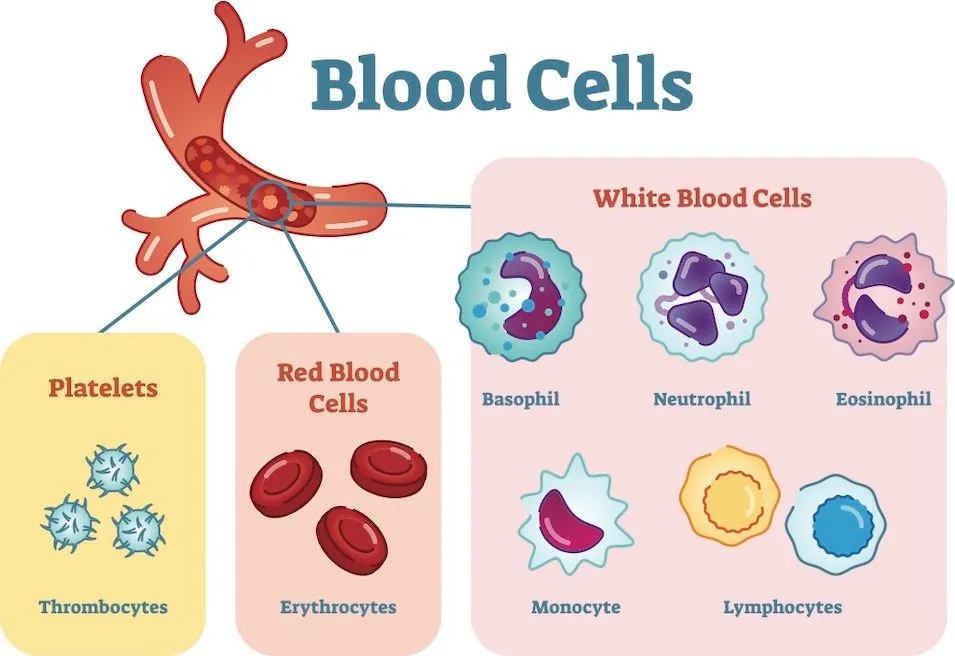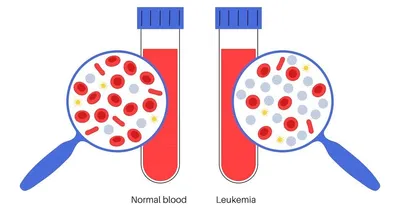What is Pancytopenia? Symptoms, Causes, & Treatments

What is pancytopenia? What causes it, and what are its treatments? Learn answers to these questions and more below!
What is Pancytopenia?
In simple terms, pancytopenia means your body is not producing enough of all blood cell types (red, white, and platelets). Various things can cause pancytopenia. Identifying the cause can help determine the right treatment. If a cause cannot be found, it is called idiopathic pancytopenia. To learn about how this condition is managed, please see the treatment section below.

What are the Symptoms of Pancytopenia?
Symptoms of pancytopenia can vary from mild to severe. Because all blood cells are affected, you might experience symptoms related to the following conditions:
-
Anemia: Low red blood cells. You may experience symptoms like fatigue and pale skin.
-
Leukopenia: Low white blood cells. A symptom of low white blood cells includes experiencing increased infections.
-
Thrombocytopenia: Low platelets. You may experience easy bruising or bleeding. In some cases, the bruises may appear as small red dots.
What Causes Pancytopenia?
Various conditions can cause blood cells to decrease. Some of these include:
Active infections like parvovirus B19, hepatitis, human immunodeficiency virus (HIV), cytomegalovirus, Epstein-Barr virus, COVID-19, tuberculosis, and malaria.
Autoimmune conditions involve immune cells that attack healthy blood cells. These include systemic lupus erythematosus, rheumatoid arthritis, and sarcoidosis.
Nutritional abnormalities if there are not enough nutrients to make an adequate amount of healthy blood cells, or if excessive intake of toxic substances damages the bone marrow. Nutritional abnormalities linked to pancytopenia include vitamin B12 deficiency, folate deficiency, excessive alcohol intake, and malnutrition.
Cancers that affect blood cell production in the bone marrow like multiple myeloma, types of lymphomas, leukemias, myelodysplatic syndromes, and myeloproliferative neoplasms. Click here to find a comprehensive list of blood cancers.
Other cancers that started outside of the bone marrow and made their way to the bone marrow can also affect healthy blood cell production.
Blood or bone marrow disorders like aplastic anemia, paroxysmal nocturnal hemoglobinuria, Fanconi anemia, and Diamond-Blackfan anemia.
Exposure to cancer treatment like chemotherapy or chemicals like benzene may damage or decrease the production of healthy blood cells.
Blood cell buildup in the spleen, also called splenic sequestration, can lead to pancytopenia. This can occur due to alcoholic liver cirrhosis, portal hypertension, infections, autoimmune disease, cancers, or due to storage diseases such as Gaucher’s disease.
What are the Treatments for Pancytopenia?
If your doctor finds that multiple types of your blood cell counts are low, they will likely screen you for the above health conditions that could contribute to pancytopenia. Once the source of the issue is located, the condition causing healthy blood cells to decrease will be treated.
To help increase low blood cell counts during the treatment of the root cause, you may receive supportive measures like:
-
Red blood cell transfusion
-
-
Infection-fighting medicines like antibiotics, antivirals, and immunoglobulin infusions (IVIG) to decrease the risk of infections if you have low white blood cells
Conclusion
In summary, pancytopenia is a condition characterized by the decrease of all types of blood cells, leading to a wide array of symptoms, including fatigue, increased infections, and easy bruising. The causes of pancytopenia are diverse, ranging from autoimmune diseases to nutritional deficiencies and various cancers. Identifying the underlying cause with your doctor is crucial for effective management.
Accelerate the discovery of new treatment options by creating an account at HealthTree Cure Hub, an innovative tool that powers life-saving research!
If you are interested in finding a clinical trial, locating a specialist, or finding side effect solutions, you can create a free HealthTree Cure Hub account by clicking the button below!
Sources:
What is pancytopenia? What causes it, and what are its treatments? Learn answers to these questions and more below!
What is Pancytopenia?
In simple terms, pancytopenia means your body is not producing enough of all blood cell types (red, white, and platelets). Various things can cause pancytopenia. Identifying the cause can help determine the right treatment. If a cause cannot be found, it is called idiopathic pancytopenia. To learn about how this condition is managed, please see the treatment section below.

What are the Symptoms of Pancytopenia?
Symptoms of pancytopenia can vary from mild to severe. Because all blood cells are affected, you might experience symptoms related to the following conditions:
-
Anemia: Low red blood cells. You may experience symptoms like fatigue and pale skin.
-
Leukopenia: Low white blood cells. A symptom of low white blood cells includes experiencing increased infections.
-
Thrombocytopenia: Low platelets. You may experience easy bruising or bleeding. In some cases, the bruises may appear as small red dots.
What Causes Pancytopenia?
Various conditions can cause blood cells to decrease. Some of these include:
Active infections like parvovirus B19, hepatitis, human immunodeficiency virus (HIV), cytomegalovirus, Epstein-Barr virus, COVID-19, tuberculosis, and malaria.
Autoimmune conditions involve immune cells that attack healthy blood cells. These include systemic lupus erythematosus, rheumatoid arthritis, and sarcoidosis.
Nutritional abnormalities if there are not enough nutrients to make an adequate amount of healthy blood cells, or if excessive intake of toxic substances damages the bone marrow. Nutritional abnormalities linked to pancytopenia include vitamin B12 deficiency, folate deficiency, excessive alcohol intake, and malnutrition.
Cancers that affect blood cell production in the bone marrow like multiple myeloma, types of lymphomas, leukemias, myelodysplatic syndromes, and myeloproliferative neoplasms. Click here to find a comprehensive list of blood cancers.
Other cancers that started outside of the bone marrow and made their way to the bone marrow can also affect healthy blood cell production.
Blood or bone marrow disorders like aplastic anemia, paroxysmal nocturnal hemoglobinuria, Fanconi anemia, and Diamond-Blackfan anemia.
Exposure to cancer treatment like chemotherapy or chemicals like benzene may damage or decrease the production of healthy blood cells.
Blood cell buildup in the spleen, also called splenic sequestration, can lead to pancytopenia. This can occur due to alcoholic liver cirrhosis, portal hypertension, infections, autoimmune disease, cancers, or due to storage diseases such as Gaucher’s disease.
What are the Treatments for Pancytopenia?
If your doctor finds that multiple types of your blood cell counts are low, they will likely screen you for the above health conditions that could contribute to pancytopenia. Once the source of the issue is located, the condition causing healthy blood cells to decrease will be treated.
To help increase low blood cell counts during the treatment of the root cause, you may receive supportive measures like:
-
Red blood cell transfusion
-
Infection-fighting medicines like antibiotics, antivirals, and immunoglobulin infusions (IVIG) to decrease the risk of infections if you have low white blood cells
Conclusion
In summary, pancytopenia is a condition characterized by the decrease of all types of blood cells, leading to a wide array of symptoms, including fatigue, increased infections, and easy bruising. The causes of pancytopenia are diverse, ranging from autoimmune diseases to nutritional deficiencies and various cancers. Identifying the underlying cause with your doctor is crucial for effective management.
Accelerate the discovery of new treatment options by creating an account at HealthTree Cure Hub, an innovative tool that powers life-saving research!
If you are interested in finding a clinical trial, locating a specialist, or finding side effect solutions, you can create a free HealthTree Cure Hub account by clicking the button below!
Sources:

about the author
Megan Heaps
Megan joined HealthTree in 2022. She enjoys helping patients and their care partners understand the various aspects of the cancer. This understanding enables them to better advocate for themselves and improve their treatment outcomes.
Get the Latest Adult T-cell Leukemia / Lymphoma Updates, Delivered to You.
By subscribing to the HealthTree newsletter, you'll receive the latest research, treatment updates, and expert insights to help you navigate your health.








